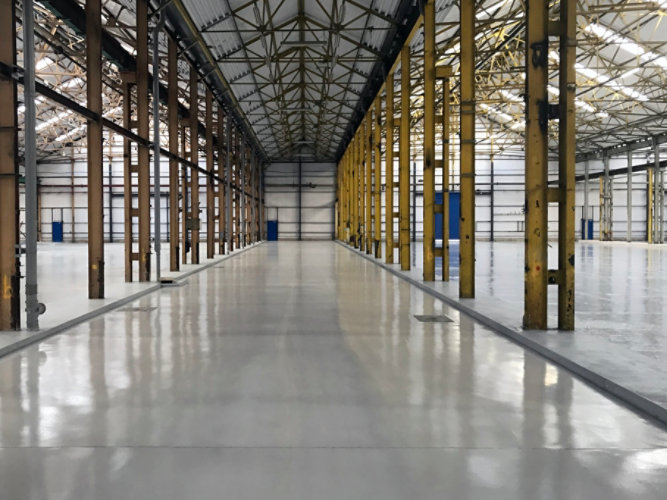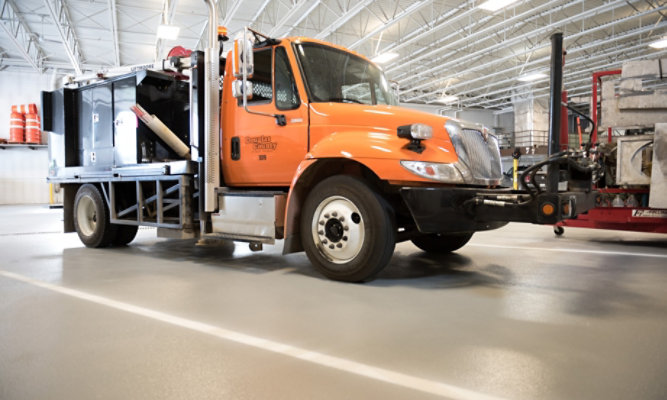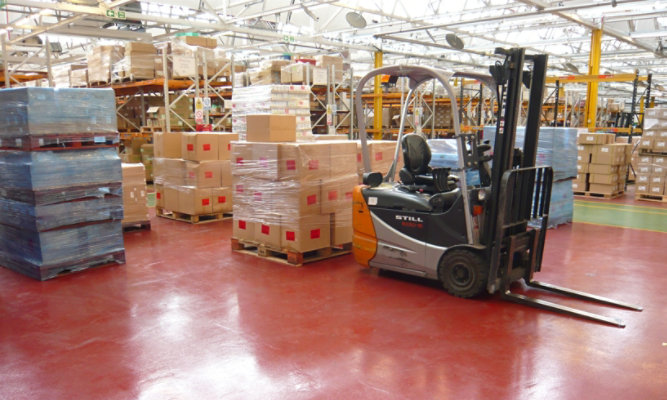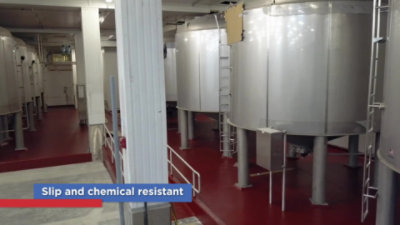
How are Poured Epoxy Floors Installed?
Epoxy and other resinous floor coatings are installed as liquids. Poured epoxy flooring, also referred to as “self-leveling” epoxy flooring, is actually comprised of two or more components, such as a specially-formulated epoxy resin and a carefully measured amount of epoxy curing agent that get carefully blended at the job site. The flooring application begins by pouring out ribbons of the blended material onto the prepared concrete substrate and quickly spreading the product using a notched or flat squeegee.
Does Poured Flooring Need to Be Repaired?
Today’s solvent-free, low VOC poured epoxy flooring formulations typically have a thicker consistency that allows it to help smoothen small divots, scratches and other minor imperfections in the concrete surface. However, cracks, holes, gouges and other more serious damage do require repair prior to the floor coating application, if a smooth final result is desired.
Seamless Poured Flooring and Why It Matters
An epoxy poured flooring or similar fluid-applied system has the advantage of being virtually seamless—no grout lines between tiles, seams between sheets of linoleum or plank flooring. Additionally, the 90 degree angles of floor to wall junctures can be eliminated with the installation of an integral epoxy cove base. This seamless system has several powerful advantages:
- Easier to clean. Seams and grout lines provide dirt, bacteria, and other debris a place to accumulate that is exceptionally difficult to properly clean. The ability to efficiently and consistently sanitize a flooring system is particularly important for hospitals, veterinary clinics, food processing facilities, pharmaceutical production plants, and many other facilities. Additionally, high performance poured epoxy flooring and other resinous floors offer exceptional resistance to a broad range of harsh sanitizers.
- Can last longer. Spilled substances remain on the surface for safe cleanup, rather than leaking through floor seams and entering the slab below. Once moisture or cleaning chemicals have the opportunity to enter the concrete slab, they can cause accelerated breakdown of the adhesives and grouts used to secure tile, sheet and plank floors, resulting in delamination, bond issues and damage to the floor coverings themselves. Additionally, seamless poured epoxy floors are devoid of the weak spots around the edges of tiles, as well as the heat-welded seams of many plank floors, both of which can tend to crack and crumble with time.
- Easy maintenance and replacement. A properly installed poured epoxy floor is very economical to clean and typically requires only minimal upkeep, with no waxing. It’s always advisable to carefully review the floor coating manufacturer’s cleaning and maintenance guidelines, however, regular removal of debris with a broom or mechanical sweeper and occasional mopping or mechanical scrubbing with a soft bristle brush and a surfactant type cleaner is a standard recommendation. Depending upon the type of poured epoxy flooring installed, as well as choice of high performance topcoats applied, many systems are capable of withstanding harsh industrial cleaning solutions and sanitizers, while maintaining their beautiful finish.
Well-selected and properly installed poured epoxy flooring is designed to stand up to daily wear-and-tear throughout its long usable life, offering significant savings over time with its simple maintenance and infrequent replacement. When the time does eventually come for floor replacement, a simple refresher coat, new epoxy system or other type of resinous floor can often be installed directly on top of the existing surface, eliminating the need to completely remove the old floor covering or incur expensive disposal costs, as seen with expired tile or other flooring material.
Poured Epoxy Flooring Installation
The term “self-leveling epoxy flooring” can sometimes create the misperception that its installation is a simple, straightforward DIY project. Nothing could be further from the truth. Installation of industrial grade poured epoxy flooring requires the skills of a factory-approved technical crew for best results. Proper concrete preparation involving careful evaluation of the surface and slab, assessment of substrate moisture content and moisture transmission, surface decontamination as needed, followed by appropriate mechanical grinding or shot-blasting, is just part of what is needed prior to successful installation of high performance poured epoxy facility flooring.
Manufacturer-approved installers understand the types of concrete imperfections that can be masked by the applied thickness of the poured epoxy system itself, versus surface deficiencies that require patching, filling or other repair in advance of coating application. Professional installation can help ensure your poured epoxy flooring system looks and performs as designed over time.
Discover More
Industry Expertise and Innovation
See how we help customers find customized solutions for their project and application challenges.
System Lookup
Find out more about our innovative floor systems for a variety of industries.
FIND A SYSTEM

